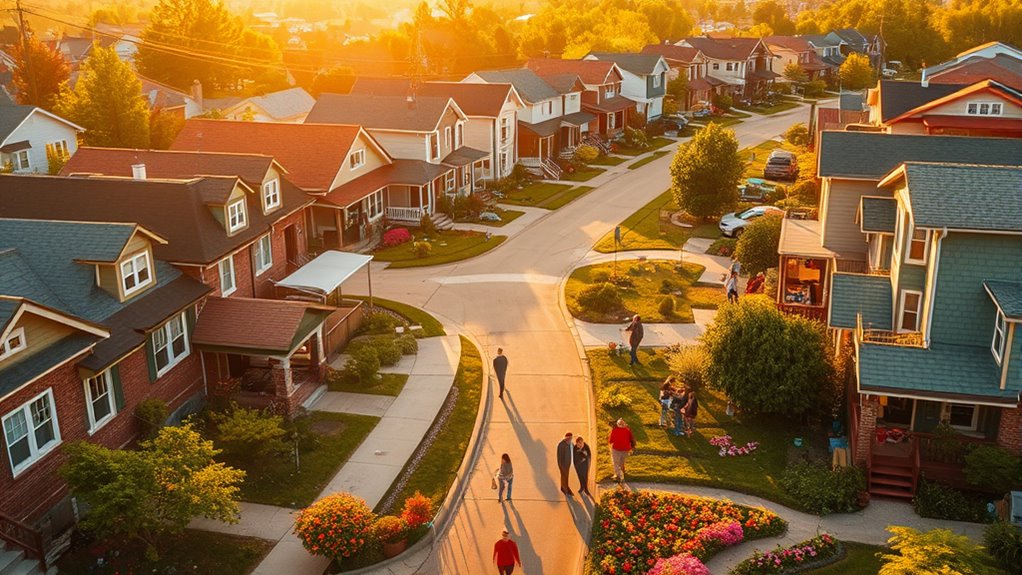To turn neighbors into a safety net with a social-support map, start by reflecting on your existing connections and noting who you trust for emotional or practical help. Deepen relationships through simple acts like introducing yourself or volunteering. Identify community members with special skills and clarify who’s accessible in emergencies. Strengthening these bonds creates trust and mutual aid, making your neighborhood safer and more connected. Keep exploring to discover how to build and enhance this supportive network even further.
Key Takeaways
- Reflect on existing local connections and identify who can offer emotional, practical, or advisory support.
- Deepen relationships through simple acts like introductions, shared activities, or volunteering to strengthen bonds.
- Map each contact’s support role and accessibility in emergencies to ensure reliable assistance when needed.
- Nurture weaker ties and seek new connections to fill gaps, enhancing overall community resilience.
- Organize neighborhood gatherings or support groups to foster trust, collective responsibility, and mutual aid.

Have you ever wondered where to turn when you need help or reassurance? Building a strong social support network is essential, especially in times of crisis or uncertainty. The social-support map offers a practical way to visualize and strengthen your connections with neighbors, friends, and community members, turning them into a reliable safety net. This map isn’t just about listing contacts; it’s about understanding who’s available, what they can offer, and how you can foster reciprocal relationships. It helps you identify gaps in your support system and encourages you to develop new connections where needed.
Creating a social-support map begins with reflection. Think about the people around you—neighbors, coworkers, local business owners, or community leaders. Write down their names and note how you know them. Do you chat over the fence, share meals, or collaborate on neighborhood projects? Recognizing these interactions helps you see existing bonds that can be strengthened. Next, consider what kind of support each person could provide in different situations—emotional comfort, practical help, or advice. For instance, a neighbor might be willing to pick up groceries if you’re feeling under the weather, while a coworker could offer professional guidance.
Start by reflecting on your community—neighbors, coworkers, and local leaders—to identify existing bonds and potential support.
As you build this map, look for opportunities to deepen those relationships. Simple acts like introducing yourself to new neighbors or volunteering for community events can transform acquaintances into trusted allies. The goal is to create a network where support flows both ways. You’ll want to identify who’s most accessible in emergencies and who can provide specific types of help. For example, some neighbors might be especially handy with tools or transportation, while others excel at emotional support. This clarity ensures you’re prepared when a need arises.
The social-support map also helps you see how resilient your community is. If many connections are one-sided or superficial, it’s a sign that you should nurture those relationships further or seek new ones. Strengthening your neighborhood’s social fabric benefits everyone, creating a sense of shared responsibility and trust. You might consider organizing neighborhood gatherings or support groups, making it easier to connect and communicate. These activities foster a collective safety net, where everyone feels responsible for each other’s well-being. Additionally, practicing home improvement skills together can build community bonds and mutual trust.
In the end, turning neighbors into a safety net isn’t about expecting constant help but about creating a web of trust and mutual support. By actively mapping out your community and cultivating those relationships, you ensure that when tough times come, you’re not alone. Instead, you have a network of people who genuinely care and are willing to lend a hand, making your neighborhood a safer, more connected place to live.
Frequently Asked Questions
How Can I Start Building My Social-Support Map?
Start by listing your neighbors and community contacts. Reach out with simple greetings or small talk to build familiarity. Attend local events or join neighborhood groups to connect more deeply. Keep track of who’s willing to help or provide support in different situations. As you develop these relationships, you’ll create a network you can rely on during emergencies or everyday needs, turning neighbors into your trusted safety net.
What Are Common Challenges in Creating a Neighbor Support Network?
You might face hesitation, fear of rejection, or awkwardness when building your neighbor support network. It’s natural to worry about imposing or not knowing where to start. Sometimes, neighbors seem distant or busy, making connection tough. But don’t give up—start small, share a smile, or ask for help. With patience, those initial steps can open trust and turn strangers into a reliable, supportive community.
How Does the Map Adapt During Emergencies or Crises?
During emergencies or crises, the map adapts by quickly highlighting key contacts and resources nearby. You can update it in real-time to include urgent needs and available help, making coordination easier. It prompts you to connect with neighbors who can assist, share critical information, or offer supplies. This dynamic tool keeps everyone informed and prepared, ensuring that support flows efficiently where it’s needed most in stressful situations.
Can Digital Tools Improve the Effectiveness of the Social-Support Map?
Digital tools can markedly boost the social-support map’s effectiveness by making it easier for you to connect and communicate with neighbors. You can quickly share updates, request help, or coordinate assistance during emergencies. Mobile apps and online platforms also help you identify community resources and maintain your network even when physical contact isn’t possible. This technology empowers you to build a stronger, more responsive support system within your neighborhood.
How Do Cultural Differences Influence Neighbor Support Systems?
Cultural differences shape how you perceive and engage with neighbor support systems. In some cultures, you feel comfortable asking for help and offering it freely, fostering strong bonds. In others, you might hesitate due to norms of independence or privacy. Understanding these differences helps you build trust and tailor your approach, ensuring your support efforts resonate. Recognizing cultural nuances allows you to strengthen community ties and create a reliable safety net.
Conclusion
Imagine your neighborhood as a woven tapestry, each neighbor a essential thread. When one strand weakens, the whole picture suffers. The social-support map helps you strengthen those connections before trouble strikes, turning neighbors into an unbreakable safety net. Just like a community garden needs every plant to thrive, your support network grows stronger with each act of kindness. Together, you create a safety net that catches you when life’s storm clouds gather.









